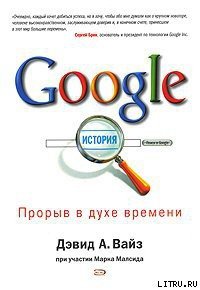Работа рулит! Почему большинство людей в мире хотят работать именно в Google - Бок Ласло (читать книги бесплатно TXT) 📗
90. Maslow A. H. The Psychology of Science: A Reconnaissance. New York: Joanna Cotler Books, 1966. P. 15.
91. Каждый интервьюер присуждал кандидату баллы от 0,0 до 4,0, а потом проводилось усреднение для получения единого балла. 3,0 номинально означал, что кандидата следует пригласить на работу, но на практике почти все нанятые имели балл от 3,2 до 3,6. Среднего балла 4,0 не получал никто и никогда.
92. Smith D. Desmond Tutu Attacks South African Government over Dalai Lama Visit // Guardian, 2011. October 4 // http://www.theguardian.com/world/2011/oct/04/tutu-attacks-anc-dalai-lama-visa.
93. Видео можно посмотреть здесь: http://www.youtube.com/watch?v=97bZu-tXLq4.
94. Dalberg J. E. E. Lord Acton, Letter to Bishop Mandell Creighton, April 5, 1887 // Historical Essays and Studies, eds. John Neville Figgis and Reginald Vere Laurence. London: Macmillan, 1907. P. 504.
95. Discovering Psychology with Philip Zimbardo, PhD, updated edition, Power of the Situation, 10 минут 59 секунд с начала видео // http://www.learner.org/series/discoveringpsychology/19/e19expand.html.
96. Smith R. N. Ron Nessen. Gerald R. Ford Oral History Project // http://geraldrfordfoundation.org/centennial/oralhistory/ron-nessen/.
97. SciTech Tuesday: Abraham Wald, Seeing the Unseen. Сообщение Энни Тете, координатора по естественным наукам, технологиям, инженерному делу и математике в Национальном музее Второй мировой войны. См. блог музея, 13 ноября 2012 г.: http://www.nww2m.com/2012/11/scitech-tuesday-abraham-wald-seeing-the-unseen/. Репринт работы Уолда можно найти здесь: http://cna.org/sites/default/files/research/0204320000.pdf.
98. «Кот-юрист», lawyercat — так на гугловском сленге называют трудолюбивых и зорких гуглеров из юридической службы. И да, гуглеры часто сопровождают фотографией кота (в пиджаке, галстуке и тугом белом воротничке) внутренние дискуссии, которые могут завернуть на покрытую мраком территорию профессиональных таинств.
99. Our New Search Index: Caffeine. Google (официальный блог), 2010. June 8 // http://googleblog.blogspot.com/2010/06/our-new-search-index-caffeine.html.
100. Time to Think. 3M // http://solutions.3m.com/innovation/en_US/stories/time-to-think.
101. Tate R. Google Couldn’t Kill 20 Percent Time Even If It Wanted To // Wired, 2013. August 21 // http://www.wired.com/business/2013/08/20-percent-time-will-never-die/.
102. Babcock L., Laschever S., Gelfand M., Small D. Nice Girls Don’t Ask // Harvard Business Review, October 2003 // http://hbr.org/2003/10/nice-girls-dont-ask/. Babcock L., Laschever S. Women Don’t Ask: Negotiation and the Gender Divide. Princeton, NJ: Princeton University Press, 2003.
103. Employee Engagement: What’s Your Engagement Ratio? Gallup Consulting, Employment Engagement Overview Brochure, November 17, 2013.
104. Macey W. H., Schneider B. The Meaning of Employee Engagement // Industrial and Organizational Psychology, 2008. Vol. 1, No. 1. Pp. 3–30.
105. Serrat O. The Travails of Micromanagement. Washington, DC: Asian Development Bank, 2011 // http://digitalcommons.ilr.cornell.edu/cgi/viewcontent.cgi?article=1208&context=intl.
106. Бах Р. Иллюзии, или Приключения Мессии, который Мессией быть не хотел. Киев: София, 2014.
107. Pulakos E. D., O’Leary R. S. Why Is Performance Management Broken? // Industrial and Organizational Psychology, 2011. Vol. 4, No. 2. Pp. 146–164.
108. Results of the 2010 Study on the State of Performance Management. Sibson Consulting, 2010 // http://www.sibson.com/publications/surveysandstudies/2010SPM.pdf.
109. Ramirez J. C. Rethinking the Review // Human Resource Executive HREOnline, 2013. July 24 // http://www.hreonline.com/HRE/view/story.jhtml?id= 534355695.
110. Locke E. A., Latham G. P. A Theory of Goal Setting of Task Performance. Upper Saddle River, NJ: Prentice Hall, 1990.
111. Bezuijen X. M. van Dam K., van den Berg P. T., Thierry H. How Leaders Stimulate Employee Learning: A Leader-Member Exchange Approach // Journal of Occupational and Organizational Psychology, 2010. Vol. 83, No. 3. Pp. 673–693; Blatt B., Confessore S., Kallenberg G., Greenberg L. Verbal Interaction Analysis: Viewing Feedback Through a Different Lens // Teaching and Learning in Medicine, 2008. Vol. 20, No. 4. Pp. 329–333.
112. Pulakos E. D., O’Leary R. S. Why Is Performance Management Broken? // Industrial and Organizational Psychology, 2011. Vol. 4, No. 2. Pp. 146–164.
113. Для всех гуглеров, кто это читает: использование мема одобрено Полом Коэном, Колином Макмилленом и GCPA. Что происходит на Memegen, там и остается!
114. Ashford S. J. Feedback-Seeking in Individual Adaptation: A Resource Perspective // Academy of Management Journal, 1986. Vol. 29, No. 3. Pp. 465–487; Atwater L. E., Brett J. F., Charles A. C. Multisource Feedback: Lessons Learned and Implications for Practice // Human Resource Management, 2007. Vol. 46, No. 2. Pp. 285–307; Azevedo R., Bernard R. M. A Meta-Analysis of the Effects of Feedback in Computer-Based Instruction // Journal of Educational Computing Research, 1995. Vol. 13, No. 2. Pp. 111–127; Baron R. A. Criticism (Informal Negative Feedback) As a Source of Perceived Unfairness in Organizations: Effects, Mechanisms, and Countermeasures // in Justice in the Workplace: Approaching Fairness in Human Resource Management (Applied Psychology Series), ed. Russell Cropanzano. Hillsdale, NJ: Lawrence Erlbaum Associates, Inc., 1993. Pp. 155–170; Fedor D. B., Davis W. D., Maslyn J. M., Mathieson K. Performance Improvement Efforts in Response to Negative Feedback: The Roles of Source Power and Recipient Self-Esteem // Journal of Management, 2001. Vol. 27, No. 1. Pp. 79–97; Bolton G. E., Katok E., Ockenfels A. How Effective Are Electronic Reputation Mechanisms? An Experimental Investigation // Management Science, 2004. Vol. 50, No. 11. Pp. 1587–1602. Dellarocas C. The Digitization of Word of Mouth: Promise and Challenges of Online Feedback Mechanisms // Management Science, 2003. Vol. 49, No. 10. Pp. 1407–1424.
115. Deci E. L. Effects of Externally Mediated Rewards on Intrinsic Motivation // Journal of Personality and Social Psychology, 1971. Vol. 18, No. 1. Pp. 105–115.
116. Deci E. L., Ryan R. M. Intrinsic Motivation and Self-Determination in Human Behavior. New York: Plenum, 1985; Deci E. L., Koestner R., Ryan R. M. A Meta-Analytic Review of Experiments Examining the Effects of Extrinsic Rewards on Intrinsic Motivation // Psychological Bulletin, 1999. Vol. 125, No. 6. Pp. 627–668; Ryan R. M., Deci E. L. Self-Determination Theory and the Facilitation of Intrinsic Motivation, Social Development, and Weil-Being // American Psychologist, 2000. Vol. 55, No. 1. Pp. 68–78.
117. Belliveau M. A. Engendering Inequity? How Social Accounts Create vs. Merely Explain Unfavorable Pay Outcomes for Women // Organization Science, 2012. Vol. 23, No. 4. Pp. 1154–1174 // http://pubsonline.informs.org/doi/abs/10.1287/orsc.1110.0691.
118. Личная беседа.
119. Atwater, Brett, Charles. Multisource Feedback; Blatt, Confessore, Kallenberg, Greenberg. Verbal Interaction Analysis; Brett J. F., Atwater L. E. 360° Feedback: Accuracy, Reactions, and Perceptions of Usefulness // Journal of Applied Psychology, 2001. Vol. 86, No. 5. Pp. 930–942.
120. Инженеры, разрабатывавшие прототип этой системы, остановились на 512 знаках. Изначально они хотели использовать 256 знаков, частично из-за того, что байт (единство двоичных символов, или битов) может содержать одно из 256 значений. Но потом было решено, что 256 знаков недостаточно, поэтому удвоили количество (также 256 — это 28, 512 — 29).




